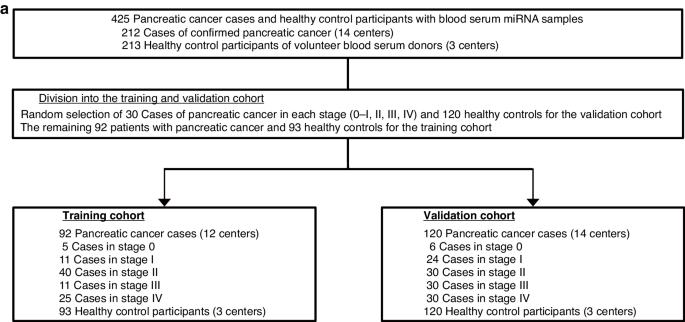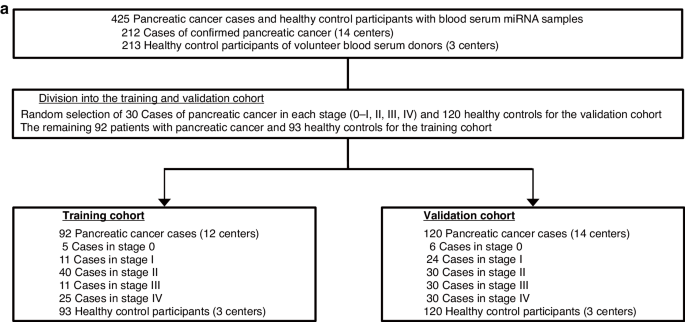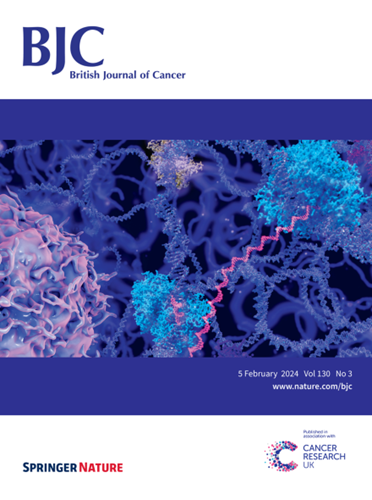利用自动机器学习对血清 miRNA 进行全面测序,早期检测胰腺癌。
IF 6.4
1区 医学
Q1 ONCOLOGY
引用次数: 0
摘要
背景:胰腺癌通常在晚期才被诊断出来:胰腺癌通常在晚期才被确诊,由于症状不特异且缺乏可用的生物标志物,胰腺癌的早期诊断十分困难:我们对来自 14 家医院的 212 份胰腺癌患者样本和 213 份非癌症健康对照样本进行了全面的血清 miRNA 测序。我们将胰腺癌样本和对照样本随机分为两个队列:训练队列(185 人)和验证队列(240 人)。我们创建了将自动机器学习与 100 个高表达 miRNA 及其与 CA19-9 的组合相结合的集合模型,并在独立验证队列中验证了模型的性能:结果:结合了100个高表达miRNA和CA19-9的诊断模型能准确区分胰腺癌和非癌症健康对照(曲线下面积(AUC)为0.99;灵敏度为90%;特异性为98%)。我们在一个独立的无症状早期(0-I 期)胰腺癌队列中验证了高诊断准确性(AUC:0.97;灵敏度:67%;特异性:98%):我们的研究表明,100 个高表达 miRNAs 及其与 CA19-9 的结合可以成为特异性早期检测胰腺癌的生物标志物。本文章由计算机程序翻译,如有差异,请以英文原文为准。


Early detection of pancreatic cancer by comprehensive serum miRNA sequencing with automated machine learning
Pancreatic cancer is often diagnosed at advanced stages, and early-stage diagnosis of pancreatic cancer is difficult because of nonspecific symptoms and lack of available biomarkers. We performed comprehensive serum miRNA sequencing of 212 pancreatic cancer patient samples from 14 hospitals and 213 non-cancerous healthy control samples. We randomly classified the pancreatic cancer and control samples into two cohorts: a training cohort (N = 185) and a validation cohort (N = 240). We created ensemble models that combined automated machine learning with 100 highly expressed miRNAs and their combination with CA19-9 and validated the performance of the models in the independent validation cohort. The diagnostic model with the combination of the 100 highly expressed miRNAs and CA19-9 could discriminate pancreatic cancer from non-cancer healthy control with high accuracy (area under the curve (AUC), 0.99; sensitivity, 90%; specificity, 98%). We validated high diagnostic accuracy in an independent asymptomatic early-stage (stage 0-I) pancreatic cancer cohort (AUC:0.97; sensitivity, 67%; specificity, 98%). We demonstrate that the 100 highly expressed miRNAs and their combination with CA19-9 could be biomarkers for the specific and early detection of pancreatic cancer.
求助全文
通过发布文献求助,成功后即可免费获取论文全文。
去求助
来源期刊

British Journal of Cancer
医学-肿瘤学
CiteScore
15.10
自引率
1.10%
发文量
383
审稿时长
6 months
期刊介绍:
The British Journal of Cancer is one of the most-cited general cancer journals, publishing significant advances in translational and clinical cancer research.It also publishes high-quality reviews and thought-provoking comment on all aspects of cancer prevention,diagnosis and treatment.
 求助内容:
求助内容: 应助结果提醒方式:
应助结果提醒方式:


